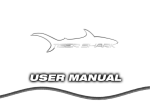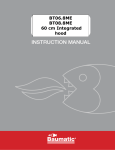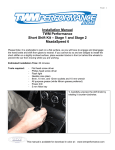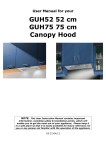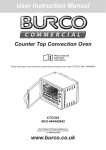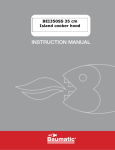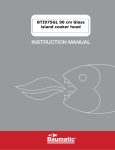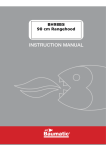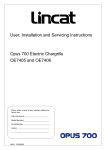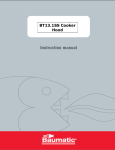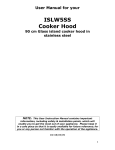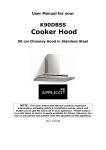Download waeady - Waterline
Transcript
User Manual for your BTW600ME 60 cm Integrated hood NOTE: This User Instruction Manual contains important information, including safety & installation points, which will enable you to get the most out of your appliance. Please keep it in a safe place so that it is easily available for future reference; for you or any person not familiar with the operation of the appliance. GS 27/02/12 Contents Page Environmental note 3 IMPORTANT SAFETY INFORMATION 4–6 Specifications of your cooker hood 7 Using your cooker hood Before first use To use your cooker hood Turning the cooker hood off 8–9 8 8–9 9 Cleaning your cooker hood Cleaning The grease filter 10 10 10 Maintenance Removing and replacing the grease filter Changing a light bulb Fitting the carbon filters 11 11 12 13 - Installation Electrical connection Before beginning installation Installing your cooker hood Installing the décor door Connecting to external ducting 15 15 16 17 20 22 - 23 – 16 - 17 – 19 - 22 Extraction mode or recirculation mode? Completing the installation 23 23 Troubleshooting 24 - 25 Contact details 28 14 12 13 14 2 ENVIRONMENTAL NOTE Note: Before discarding an old appliance, switch off and disconnect it from the power supply. Cut off and render any plug useless. Cut the cable off directly behind the appliance to prevent misuse. This should be undertaken by a competent person. CONFORMITY TO W.E.E.E. DIRECTIVE 3 IMPORTANT SAFETY INFORMATION Your safety is of the utmost importance to us. Please make sure that you read this instruction booklet before attempting to install or use the appliance. If you are unsure of any of the information contained in this booklet, please contact the Advice Line. IMPORTANT: Any installation work must be carried out by a qualified electrician or competent person. o The hood must be installed in accordance with the installation instructions and all measurements followed. o If the cooker hood is installed for use above a gas appliance then the provision for ventilation must be in accordance with the Gas Safety Codes of Practice BS.6172, BS.5440 & BS.6891 (Natural Gas) and BS.5482 (LP Gas) 1994, the Gas Safety (Installation & Use) Regulations, the Building Regulations issued by the Department of the Environment, the Building Standards (Scotland) (Consolidated) Regulations issued by the Scottish Development Department. o It is dangerous to alter the specifications or to modify this product in any way. Do not tamper with or attempt to modify the appliance in any way. o When installing the hood, ensure that the following recommended distances are observed between the highest point on the hob top (including the burners) and the bottom of the cooker hood: Electric cookers: Gas cookers: Coal/ oil cookers: 700 mm 700 mm 800 mm IMPORTANT: DO NOT SET YOUR COOKER HOOD LESS THAN 700mm ABOVE YOUR COOKER. o When installed between adjoining wall cabinets, the cabinets must not overhang the hob. 4 o The edges of the cooker hood are sharp – be mindful of this as you handle your appliance, especially during installation and cleaning. DO NOT CLEAN IN BEHIND THE GREASE FILTER! o If the room where the cooker hood is to be used contains a fuel burning appliance such as a central heating boiler then its flue must be of the sealed or balanced flue type. o If other types of flue or appliances are fitted, ensure that there is an adequate supply of air in the room. o When the hood is being used in extraction mode, ensure that the ducting is fire retardant and that there are no bends greater than 90 degrees as this will reduce the efficiency of the hood. o Ensure the ducting for the extractor mode has the same diameter as the outlet hole all the way through. o Keep young children from using, playing with or tampering with the cooker hood. Older children and infirm persons should be supervised if they are using the cooker hood. o Your cooker hood is for domestic use only. o Please dispose of the packing material carefully – children are especially vulnerable to it. o Dirty oil is an even greater fire risk. o Always put lids on pots and pans when cooking on a gas cooker. o The manufacturer refuses to accept any responsibility for damages arising to the hood or for it catching on fire, from a failure to observe the fire safety advice contained in these instructions. 5 o Remember that when in extraction mode, your cooker hood is removing air from your room. Ensure that proper ventilation measures are being observed. o Note that the cooker hood removes odours from your kitchen, not steam. o Warning - Always ensure that the cooker hood has been disconnected from the power supply before carrying out any work on the hood, including cleaning and replacing light bulbs. o Do not connect the ducting system of this appliance to an existing ventilation system being used for any other purpose. o Do not install above a cooker with a high level grill. o Never leave frying pans unattended during use as overheated fats and oils might catch fire. o The cooker hood should not be exposed to a direct heat source from the cooking device underneath it, i.e. naked flame from a gas burner or heat from electric hob zones without a pan on them. o Do not attempt to use the cooker hood if it is damaged in any way. Never attempt to use it without the grease filter fitted or if the filter is excessively greasy! o Never flambé cook under this cooker hood. o The lights on this appliance should only be used during operation of the cooker hood. They should not be left on permanently and used as a lighting source. THE MANUFACTURER DECLINES ALL RESPONSIBILITY IN THE EVENT OF FAILURE TO OBSERVE THE INSTRUCTIONS GIVEN HERE, FOR INSTALLATION, MAINTENANCE AND SUITABLE USE OF THE HOOD. 6 Specifications of your cooker hood DIMENSIONS: Width: Depth: Height: 600 mm 282 mm 395 mm Your Cooker Hood is fitted with: o Integrated axial motor o Slider control operation o 3 Speeds o 1 light o 1 synthetic grease filter o Extraction capacity: 250 m³/hr o Noise level: 45 / 50 / 55 dB Optional Extra: 1 x pair ST1 carbon filters for air recirculation mode 7 Using your cooker hood Before first use IMPORTANT: THIS PROCESS MUST BE FOLLOWED BEFORE THE COOKER HOOD IS USED FOR THE FIRST TIME. o You should clean the appliance using a brand new cloth, with warm soapy water before using the appliance for the first time. You should then dry it thoroughly using a soft cloth. To use your cooker hood o Make sure that it has been installed by a suitably qualified person, as per the information contained in the installation instructions. o When you cook, pull up the covering metal board and turn on the cooker hood. You can then select the motor speed. When you finish cooking, push down the covering metal board and turn the cooker hood off. o There are two sliders on the control panel, which perform separate functions. Light control switch 0 1 = = Light bulb off Light bulb on 8 Motor speed control switch 0 = Off 1 = Low speed 2 = Medium speed 3 = High speed o When you next turn the cooker hood on, the motor speed will remain the same as when you last used it unless you switch the motor speed to 0. Turning the cooker hood off You can turn the cooker hood in two ways: o The cooker hood can be switched off by setting the motor speed control to 0. o You can push down the covering metal board to switch the cooker hood off however the wind speed will remain the same when you next lift the cover up. IMPORTANT: IDEALLY YOU SHOULD TURN ON YOUR HOOD TEN MINUTES BEFORE YOU START TO COOK, OR AT THE VERY LEAST WHEN YOU BEGIN COOKING. YOU SHOULD ALSO RUN YOUR HOOD FOR TEN MINUTES AFTER YOU HAVE FINISHED COOKING. 9 Cleaning your cooker hood IMPORTANT: BEFORE CLEANING, ALWAYS ENSURE THAT YOU HAVE SWITCHED YOUR COOKER HOOD OFF AT THE OMNI-POLAR SWITCH, SET AT THE WALL FROM THE CABLE. Cleaning o Clean the external parts of your cooker hood with mild liquid detergent and a new damp cloth. o Never use abrasive powder, corrosive solvents or brushes. o Never insert pointed objects into the motor’s protective grid. o Only clean the control panel and filter grill with mild liquid detergents and a new damp cloth. o If you are using the appliance in recirculation mode, then be sure to replace the carbon filters at the recommended interval (see section on “Fitting the carbon filter”). A build up of grease could cause a fire hazard. o Never attempt to clean the area above the grease filter. The grease filter o Your cooker hood includes a grease filter which helps to absorb grease particles to protect your kitchen and furniture from greasy residues. o To prevent this fire hazard, the filter should be replaced occasionally. Depending on use, this should be done every 3 months, following the method shown in the next section. o The synthetic grease filter is not washable. o Replacement synthetic filters can Baumatic Spares Department. be purchased from the 10 Maintenance Removing and cleaning the grease filter o Locate the two catches at the base of the filter as shown in the diagram above (1). o Insert a finger into each catch and gently lift and pull the filter outwards (2). o Ensure the filter unclips from the hood, as shown in the diagram above (3), before you pull it away. 11 o Remove the metal wires which hold the synthetic filter in place. o Remove the synthetic filter and replace with a new clean one. o Reattach the metal wires in their original positions to secure the synthetic filter in place. o Refit the filter in the cooker hood. Changing the light bulb IMPORTANT: BEFORE ATTEMPTING TO CHANGE THE LIGHT BULB, YOU MUST ENSURE THAT YOU HAVE DISCONNECTED THE COOKER HOOD FROM YOUR MAINS SUPPLY. o To access the light bulb you need to remove the panel located to the left of the control switches. 12 o You should use a suitable screwdriver to loosen the screws holding the panel into place. Once this is removed, you will have access to the bulb. o Unscrew the light bulb and insert a new olive shaped bulb with an E14 coupling 40W (max). o IMPORTANT: Defective bulbs should be replaced immediately. o If the light still does not work, make sure that the bulb is fitted properly into the housing before you call for technical assistance. o Once the bulb has been replaced, refit the panel by screwing the screws back into place. Fitting the carbon filters If the appliance is going to be used in recirculation mode then it is necessary to fit carbon filters. This will help to absorb unpleasant odours caused by cooking. IMPORTANT: BEFORE ATTEMPTING TO FIT OR REMOVE THE CARBON FILTERS, YOU MUST ENSURE THAT YOU HAVE DISCONNECTED THE COOKER HOOD FROM YOUR MAINS SUPPLY. o Remove the filter by locating the two catches at the base of the filter as shown in the diagram above (1). 13 o Insert a finger into each catch and gently lift and pull the filter outwards (2). o Ensure the filter unclips from the hood, as shown in the diagram above (3), before you pull it away. This will allow you access to the motor where the carbon filter should be fitted. o Hook the carbon filter which has two fixing pins (C) onto the motor (D). o Turn the carbon filter clockwise (F), until you feel it click into place. o Refit the filter, making sure it clips back into the hood correctly. o The carbon filters should be replaced every three months, or if they show signs of damage. To remove the carbon filter, turn it anticlockwise so it unlatches from the motor. 14 Installation IMPORTANT: Before installation and usage read all the instructions and make sure that the voltage (V) and the frequency (Hz) indicated on the rating plate are exactly the same as the voltage and frequency in your home. The rating plate can be found behind the grease filter. The manufacturer declines all responsibility in the event of the installer failing to observe all of the accident prevention regulations in force, which are necessary for normal use and the regular operation of the electric system. Electrical connection YOUR COOKER HOOD IS INTENDED FOR FITTED AND PERMANENT INSTALLATION. o The cooker hood’s power cable must be fitted upstream from the electrical connection, using an omni-polar switch with a contact distance of at least 3 mm. THE FUSE MUST BE RATED AT 3 AMPS. WARNING: THIS APPLIANCE MUST BE EARTHED. It should only be connected by a competent person, using fixed wiring via a double pole switched fused spur outlet. (UK ONLY). We recommend that the appliance is connected by a qualified electrician, who is a member of the N.I.C.E.I.C. and who will comply with the I.E.E. and local regulations. The wires in the mains lead are coloured in accordance with the following UK code: Blue = Neutral, Brown = Live, Green/Yellow = Ground If you only find two wires in the main’s lead (blue and brown), then neither must be connected to the earth terminal. o As the colours of the wires in the appliance’s mains lead may not correspond with the coloured markings identifying the terminals in your spur box, please proceed as follows: o The blue wire must be connected to the terminal marked “N” (neutral), or coloured black. o The brown wire must be connected to the terminal marked “L” (live), or coloured red. 15 Before beginning installation o Check that the product purchased is of a suitable size for the chosen installation area. In addition check whether there is an electrical socket available that will be accessible once the hood is mounted. If the product is going to be used in extraction mode, then there should also be space to connect a ducting hose to the outside. o Carry out all necessary masonry work prior to the fitting of the cooker hood. o Ensure that all electrical connections are carried out by a suitably qualified person. o Before commencing installation of the cooker hood the grease filter should be removed. o Check inside the product and ensure that there is no transit packaging or any other materials, such as packets of screws, guarantees etc. These should be removed and kept for future use. o If possible, disconnect and move freestanding or slot-in cookers from their position, to provide easier access to the rear wall and cupboards. If this is not possible, then a thick, protective covering should be placed over the worktop, hob top or cooker. This will help to protect these surfaces from damage and debris. o Select a flat surface for assembling the cooker hood. Cover that surface with a protective covering and place all cooker hood parts and fittings on it. 16 o Do not tile, grout or silicone this appliance to the wall or cabinetry. This appliance is designed to be surface mounted only. Installing your cooker hood IMPORTANT: YOU WILL HAVE TO DECIDE BEFORE INSTALLING YOUR COOKER HOOD WHETHER TO USE IT IN EXTRACTION MODE OR RECIRCULATION MODE. PLEASE TURN TO PAGE 23 NOW TO UNDERSTAND THE DIFFERENCES BETWEEN THESE TWO MODES. o We recommend that at least two people install this hood. o Your cooker hood should only be fitted to a wall and secured between two cupboards. o It must be positioned at least 700 mm above the hob underneath it. This measurement should be taken from the highest point on the hob, including the burners. IMPORTANT: YOUR COOKER HOOD SHOULD BE CONNECTED TO YOUR MAINS SUPPLY AFTER THE REST OF THE INSTALLATION PROCESS HAS BEEN COMPLETED. o Remove the filter by locating the two catches at the base of the filter as shown in the diagram above (1). 17 o Insert a finger into each catch and gently lift and pull the filter outwards (2). o Ensure the filter unclips from the hood, as shown in the diagram above (3), before you pull it away. o Install the cooker hood between two cupboards. o Drill and insert the screws onto the side boards of the cupboards (the holes should be no larger than 2 mm). The distance between the head of the screw and the side board should be 5 mm. The distance between the screw and the cooking surface below should be no less than 1040 mm. If there is not enough room you can place the screws higher or lower. 18 o Hang the cooker hood onto the screws between the two cupboards. o Push the fan-shaped door frames to the end (fully closed), in order to ensure the outer edges of the door frames are parallel to the outer edge of the adjacent cupboards (not the doors). o Mark the positions where the lower screws are to be fixed. o Drill the upper hole and fix the screws, ensuring that all four screws are secured tightly. o Connect the air outlet board and the air outlet tube. 19 Installing the décor door o The door should be no less than 16 mm thick, 385-700 mm high and weigh no more than 7 kg. o Pull out the movable fan-shaped door frames, which are located in two curved plastic slides on each side of the cooker hood. They are prevented from being pulled out too far by plastic limit clips. o Taking care not to drop the frame, pull gently on the plastic limit clips (1) while opening the door frames (2). Once the door frame has cleared the plastic clip, the door frame can be removed from the hood. o Place the décor door on a protective surface. Mark the installation position of the door frame and the size of the fixed screws to ensure you do not drill too deeply and damage the décor door. 20 o If the upper edge of the door is not as high as the upper edge of the cupboards then you should adjust the size accordingly. o Mark the positions of the screws on the door and ensure the size is as accurate as 569+1 mm. o Fix the fan-shaped door frames on the door with screws, making sure the frames are symmetrical. o Install the door onto the cooker hood. The two sides of the door frames can be pulled to the end and the door can be safely locked into position by the plastic limit clips. This prevents accidental removal of the door frame from the appliance. o The two screws on both sides of the cooker hood can be adjusted to alter the sliding of the door, according to its weight. 21 o Install the adjusting plate, in order to cover the gap between the wall and the bottom of the cooker hood, by screwing it into place. Connecting to external ducting o To use the appliance in extraction mode it is necessary to install external ducting. o Select a position that is suitable for the location of the cooker hood and will be accessible once the cooker hood is installed. Cut out a circle measuring 130 mm in diameter. o The discharge outlet should be suitable for cooking vapours and it should have a cross section of at least 150 cm². o Fit a suitable ducting terminal (not supplied) to the wall and connect a 125 mm ducting hose (not supplied) to the terminal. o Connect the other end of the ducting hose to the top of the cooker hood. o The maximum distance between the cooker hood and your discharge outlet should be 3 metres with one 90° bend. For each additional 90° bend, the maximum distance is reduced by 1 metre. 22 Extraction mode or recirculation mode? IMPORTANT: YOU WILL HAVE TO DECIDE BEFORE INSTALLING YOUR COOKER HOOD WHETHER TO USE IT IN EXTRACTION MODE OR RECIRCULATION MODE. What is the difference between extraction and recirculation modes? In extraction mode, the stale air will be taken via the grease filter and out of the room via external ducting. In recirculation mode stale air is taken via the grease filter, and passed through charcoal filters for purification. The air then re-enters the kitchen via an opening in the hood. For optimum performance, we recommend that the cooker hood is used in extraction mode and connected to external ducting. Unfortunately if you live in a flat or the hood is too far from an outside wall, this may not be possible. The only alternative is to recirculate the air. Do I need a charcoal filter? All cooker hoods have a grease filter but if you are using your cooker hood in recirculation mode, then charcoal filters must be fitted in addition to the grease filter. Completing the installation If you are setting the appliance to recirculation mode, then you should now fit the two carbon filters. See the “Fitting the carbon filters” section on pages 13 - 14. The electrical connection must correspond to the electrical requirement noted on the rating plate, which is placed inside the cooker hood. The appliance should now be connected to the electrical supply. See pages 15 – 16 for detailed information on the electrical connection. Refit the grease filter and then switch on the mains supply to the appliance. Check that the appliance is operating correctly by selecting each speed and switching the light bulb on and off. 23 Troubleshooting IMPORTANT: If your cooker hood appears not to be operating properly, before contacting the Advice Line, please refer to the checklist below. My cooker hood will not start. o Check that the hood is connected to the electricity supply o Check that the fan speed control is set correctly. My cooker hood is not working effectively. o The fan speed is not set high enough o The grease filter is dirty and requires replacing. o The kitchen is not well ventilated enough. o If the hood is set up for recirculation mode, check that the carbon filters do not need replacing. o If the hood is set up for extraction mode, check that the ducting hose and discharge outlet are not blocked. My cooker hood has switched off during operation. o The safety cut-out device has been tripped. o Turn off the hob and then wait for the safety cut-out device to reset. o IMPORTANT: If you have installed your cooker hood too low, the safety cut-out device will frequently trip. Your cooker hood may become damaged if the safety cut-out device is tripped frequently. 24 IMPORTANT: If your appliance appears not to be operating correctly, then you should disconnect it from your mains supply and then contact the Advice Line on telephone number (0118) 933 6918. DO NOT ATTEMPT TO REPAIR THE APPLIANCE YOURSELF. Please note that if an engineer is asked to attend whilst the product is under guarantee and finds that the problem is not the result of an appliance fault, then you may be liable for the cost of the call out charge. The appliance must be accessible for the engineer to perform any necessary repair. If your appliance is installed in such a way that an engineer is concerned that damage will be caused to the appliance or your kitchen, then he will not complete a repair. This includes situations where appliances have been tiled in, sealed in with sealant, have wooden obstructions placed in front of the appliance, like plinths. Or any installation other than the one specified in this manual has been completed. Please refer to the conditions of guarantee that appear on the warranty card that you receive with the appliance when it is delivered. 25 United Kingdom 6 Bennet Road, Reading, Berkshire RG2 0QX United Kingdom Customer Care (0118) 933 6918 28




























